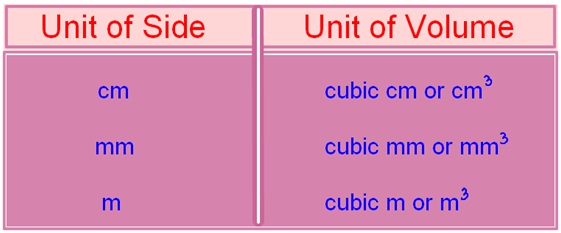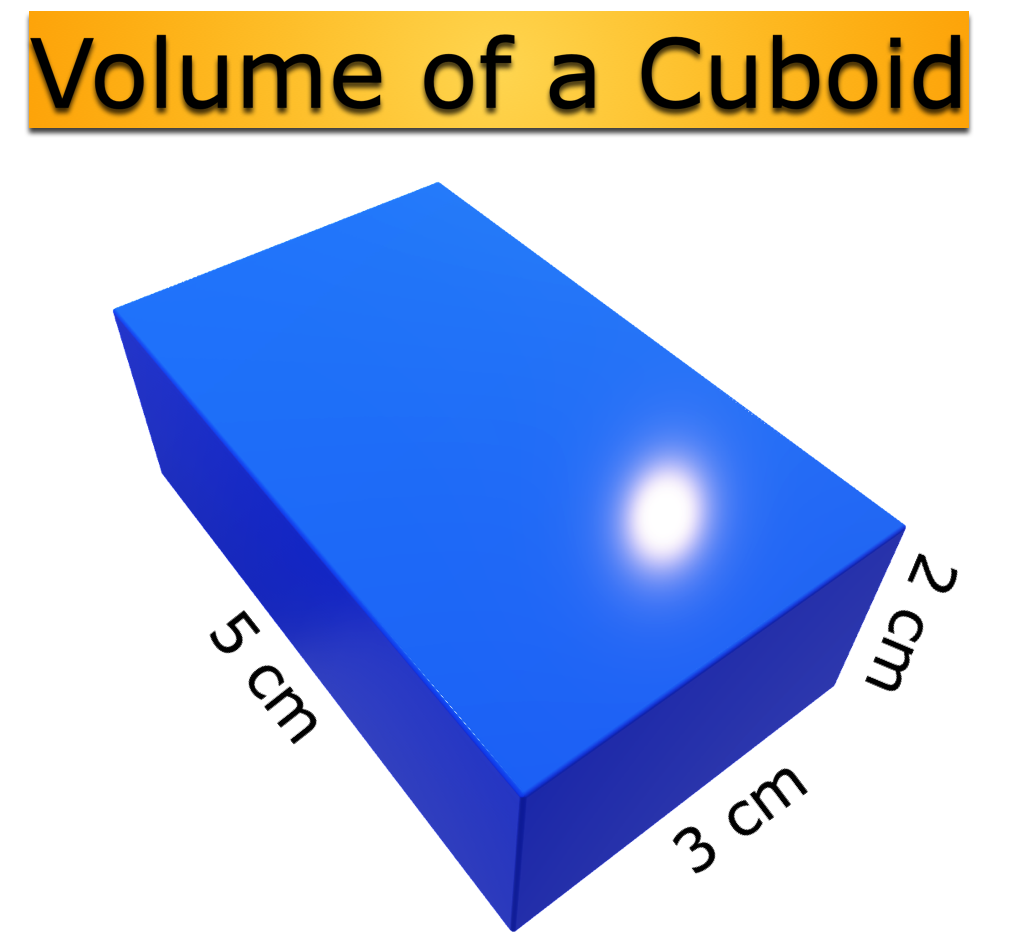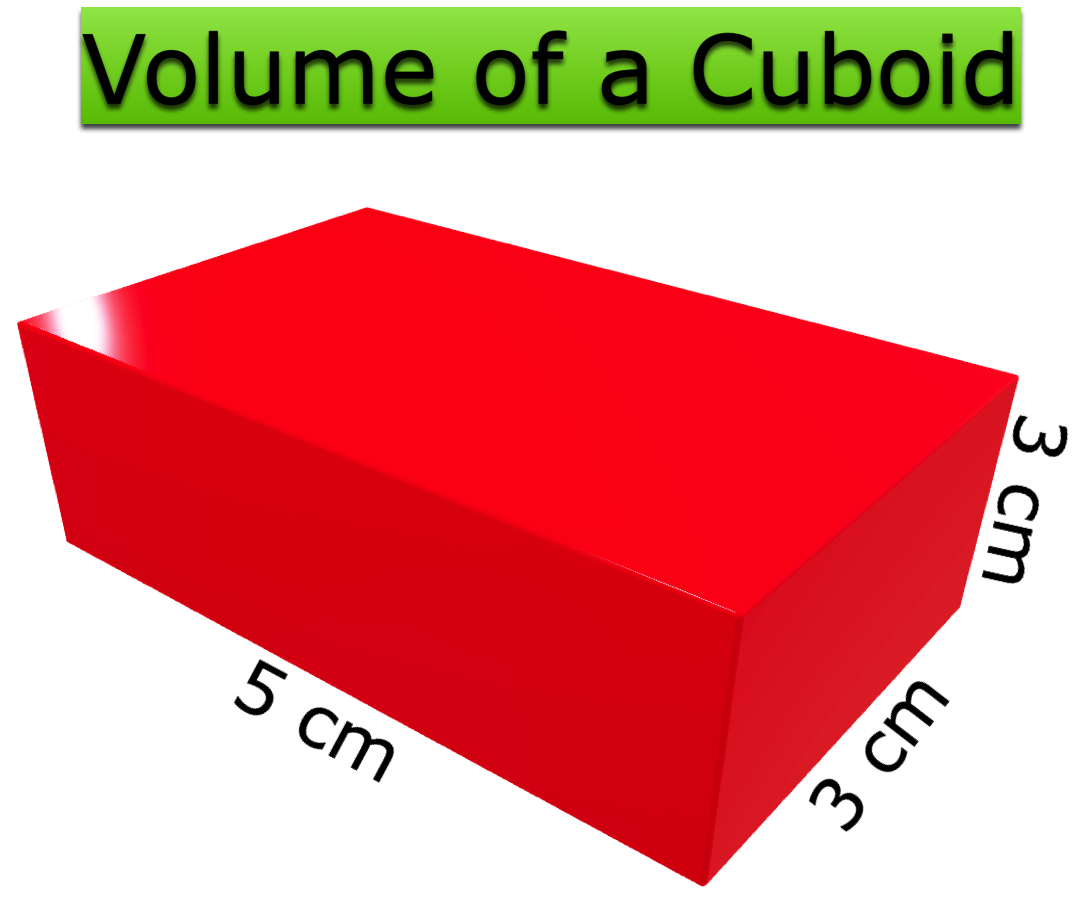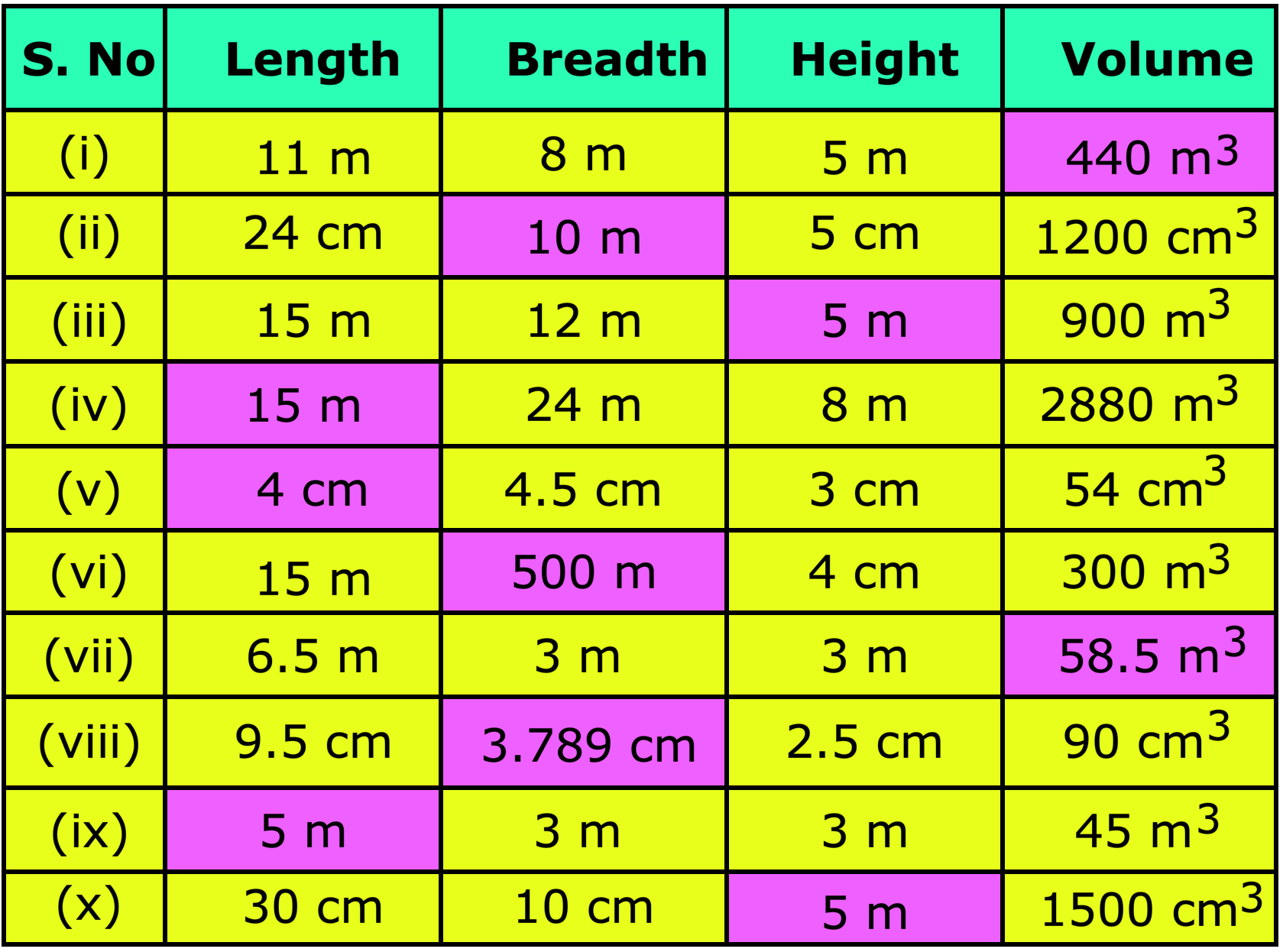Subscribe to our ▶️ YouTube channel 🔴 for the latest videos, updates, and tips.
Volume of a Cuboid
Cuboid is a solid box whose every surface is a rectangle of same area or different areas.
A cuboid will have a length, breadth and height.
Hence we can conclude that volume is 3 dimensional. To measure the volumes we need to know the measure 3 sides.
Since volume involves 3 sides it is measured in cubic units.
Volume of a cuboid = (length × breadth × height) cubic units.
= (l × b × h) cubic units.
(Since area = ℓ × b)
Volume of a cuboid = area of one surface × height cubic units
1. Let us look at the given cuboid.
The length of the cuboid = 5 cm
The breadth of the cuboid = 3 cm
The height of cuboid (thickness) = 2 cm
The number of 1 cm cubes in the given cuboid = 30 cubes = 5 × 3 × 2
We find that volume of the given cuboid with length 5 cm, breadth 3 cm and height 2 cm is 30 cu cm.
Therefore, volume of a cuboid = length × breadth × height
A cuboid is a solid figure which has length, breadth and height. It is a rectangular solid.
2. In the figure, we see a rectangular solid whose length is 5 cm, breadth is 3 cm and height is 3 cm.
For finding its volume, we divide it into unit cubes of 1 cm side.
We find that topmost layer contains 5 × 3 = 15 cubes.
Total number of such layers is 3.
So, the total cubes are 15 × 3 = 45
So, the volume of this cuboid is 45 cm3 because the volume of each cube is 1 cubic cm or 1 cm3
Volume of a cuboid = length × breadth × height
v = ℓ × b × h
For example, in the above case,
ℓ = 5 cm
b = 3 cm and
h = 3 cm
Therefore, volume of the given cuboid = (5 × 3 × 3) cm³ = 45 cm³
Word Problems on Volume of a Cuboid
Solved examples on volume of a cuboid:
1. Find the volume of a cuboid of dimensions 14 cm × 12 cm × 8 cm.
Solution:
Volume of cuboid = length × breadth × height.
Here, length = 14 cm, breadth = 12 cm and height = 8 cm.
Volume of cuboid = 14 × 12 × 8 cubic cm.
= 1344 cubic cm.
Therefore, volume of cuboid = 1344 cubic cm.
2. Michael made a shoe box with length 8 cm, breadth 6 cm and height 6 cm. Find the volume of the box.
Solution:
Volume of the shoe box = Length × breadth × height.
= 8 × 6 × 6
= 288 cu cm.
3. A fish tank is 40 cm long, 15 cm broad and 10 cm high. What is its volume in cu cm?
Solution:
The length of the fish tank = 40 cm
The breadth of the fish tank = 15 cm
The height of the fish tank = 10 cm
Therefore, the volume of the fish tank = length × breadth × height.
= 40 × 15 × 10 cu. cm
= 6000 cu cm.
4. Find the volume of a cuboid of dimensions 14 cm × 50 mm × 10 cm.
Solution:
Here, length = 14 cm,
[Given,
breadth = 50 mm; we need to convert breadth to same unit and then
solve. We know, 10 mm = 1 cm. Therefore, 50 mm = 50/10 cm = 5 cm].
Breadth = 5 cm,
Height = 10 cm.
Volume of cuboid = length × breadth × height.
= 14 × 5 × 10
= 700 cubic cm.
Therefore, volume of cuboid = 700 cubic cm.
Note: In a cuboid, when the length, breadth and height are of different units, convert them to a same unit and then solve.
5. Find the volume of a cuboid of dimensions 17 mm × 0.2 cm × 12 mm in cu. cm.
Solution:
Given, length = 17 mm.
We know, 10 mm = 1 cm.
= 17/10 cm.
= 1.7 cm.
Therefore, length = 1.7 cm.
Similarly, height = 12 mm.
We know, 10 mm = 1 cm.
= 12/10 cm.
= 1.2 cm.
Therefore, height = 1.2 cm.
Volume of cuboid = length × breadth × height.
Length = 1.7 cm, breadth = 0.2 cm and height = 1.2 cm.
= 1.7 × 0.2 × 1.2 cu. cm.
= 0.408 cu. cm.
Therefore, volume of cuboid = 0.408 cubic cm.
6. Find the number of cubical boxes of cubical side 3 cm which can be accommodated in carton of dimensions 15 cm × 9 cm × 12 cm.
Solution:
Volume of box = side × side × side.
= 3 × 3 × 3
= 27 cu. cm.
Volume of carton = length × breadth × height.
= 15 × 9 × 12
= 1620 cu. cm.
Number of boxes = Volume of carton/Volume of each box.
= 1620/27
= 60
Therefore, number of cubical boxes = 60.
7. How many bricks each 25 cm long, 10 cm wide and 7.5 cm thick will be required for a wall 20 m long, 2 m high and 0.75 m thick? If bricks sell at $900 per thousand what will it cost to build the wall?
Solution:
Volume of the wall = 20 m × 2 m × 0.75 m
= 20 × 100 cm × 2 × 100 cm × 0.75 × 100 cm
Volume of brick = 25 cm × 10 cm × 7.5 cm
Number of bricks = \(\frac{\textrm{Volume of the wall}}{\textrm{Volume of the brick}}\)
= \(\frac{20 × 100 × 2 × 100 × 0.75 × 100}{25 × 10 × 7.5}\)
= 16000
The number of bricks = 16000
The cost of 1 thousand bricks = $ 900
The cost of building the wall = $ 900 × 16 = $ 14400
Note: While calculating the volume of a cuboid all the dimensions should be changed into the same unit.
8. Find the volume of a cuboidal tank whose length, breadth and height are 10 m, 8 m, and 5 m respectively.
Solution:
Length of cuboidal tank = 10 m
Breadth of cuboidal tank = 5 m
Height of cuboidal tank = 8 m
Volume of cuboidal tank = length × breadth × height
= 10 m × 8 m × 5 m
= 400 m3
Worksheet on Volume of a Cuboid
Questions and Answers on Cuboid:
1. Find the volume of each of the cuboids.
(i) Length = 5 cm, Breadth = 4 cm and Height = 3 cm
(ii) Length = 15 m, Breadth = 10 m and Height = 2 m
(iii) Length = 0.5 m, Breadth = 3 m and Height = 4 m
(iv) Length = 3.2 cm, Breadth = 2 cm and Height = 8 cm
(v) Length = 5 m, Breadth = 1.5 m and Height = 1.2 m
Answers:
1. (i) 60 cu. cm
(ii) 300 cu. m
(iii) 6 cu. m
(iv) 51.2 cu. cm
(v) 9 cu. m
2. Find the volume of these tanks.
(i) Length = 16 cm, Breadth = 60 cm and Height = 20 cm
(ii) Length = 6 m, Breadth = 3 m and Height = 5 m
(iii) Length = 2 m, Breadth = 1.5 m and Height = 1.5 m
(iv) Length = 80 cm, Breadth = 20 cm and Height = 40 cm
(v) Length = 1.2 m, Breadth = 1.2 m and Height = 1 m
Answers:
2. (i) 19200 cu. cm
(ii) 90 cu. m
(iii) 4.5 cu. m
(iv) 64,000 cu. cm
(v) 1.44 cu. m
3. Find the volume of cuboids having the following measures.
|
Length |
Breadth |
Height | |
|
(i) |
8.5 cm |
6 cm |
3 cm |
|
(ii) |
14 cm |
11 cm |
9 cm |
|
(iii) |
30.5 cm |
25 cm |
20 cm |
|
(iv) |
15.5 m |
12 m |
8 m |
|
(v) |
7 m |
4 m |
4 m |
Answers:
3. (i) 153 cm3
(ii) 1368 cm3
(iii) 15250 cm3
(iv) 1488 m3
(v) 112 m3
4. Dimensions of the different cuboids are given below. Fill in the missing measures in the given table:
Answer:
4.
● Volume.
5th Grade Geometry
5th Grade Math Problems
From Volume of a Cuboid to HOME PAGE
Didn't find what you were looking for? Or want to know more information about Math Only Math. Use this Google Search to find what you need.







New! Comments
Have your say about what you just read! Leave me a comment in the box below. Ask a Question or Answer a Question.